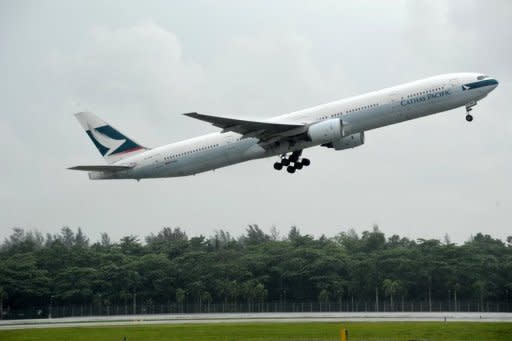Cathay Pacific posts first-half net loss
Cathay Pacific Airways posted a first-half net loss of HK$935 million ($121 million) on Wednesday, citing higher fuel prices, strong competition and economic instability in Europe. The blue-chip Asian airline's biggest loss since 2003 compared with a first-half net profit of HK$2.81 billion a year earlier, representing a 133-percent reversal. Revenue rose 4.4 percent to HK$48.86 billion. Cathay shares closed down 4.33 percent at HK$12.36, as analysts expressed surprise at the depth of the loss despite a May profit warning from the company. "It shows how poor the global economy is -- it's quite a big loss," said Daniel Tsang, an analyst at Hong Kong-based aviation consultancy firm Aspire Aviation. The results fell well short of analysts' expectations and followed a 60.8 percent drop in annual net profit to HK$5.5 billion last year, when the company's gross fuel costs soared 44.1 percent. Cathay chairman Christopher Pratt said the carrier's business had been "significantly affected by the persistently high price of jet fuel, passenger yields coming under pressure and weak air cargo demand". "These factors are common to the aviation industry as a whole. Airlines around the world are being adversely affected by the current business environment," he said in a statement. "Our profits from associated companies, including Air China, also showed a marked decline." A recent reduction in the fuel price could "provide welcome relief", Pratt said. "Our financial position remains strong and we are in a good position to deal with our current challenges," he said. To save on fuel costs, the airline has launched a huge aircraft modernisation drive and plans to reduce passenger services on trans-Pacific routes to enable the more fuel-efficient Boeing 777-300ER aircraft to replace older Boeing 747-400s. "The Cathay Pacific Group will take delivery of 19 aircraft in 2012. This will improve the operational efficiency of the fleet," Pratt said, adding that a total of 92 planes were on order for delivery up to 2019. Plans to retire the fleet of less fuel efficient Boeing 747-400 passenger aircraft would be accelerated, he said.Despite the efficiency drive, Cathay had increased some services in Asia, where demand was "relatively robust and fuel accounts for a smaller portion of operating costs". Budget-airline subsidiary Dragonair added frequencies on routes to secondary cities in mainland China and resumed flights to six destinations including Chiang Mai in Thailand. It would introduce flights to Kolkata in India and Haikou in China later in 2012. Cathay carried 14.3 million passengers in the first six months, a rise of 8.6 percent. "The premium class load factor was adversely affected, with employees of major corporations travelling less," Pratt said. The company said economic instability in Europe had a "significant effect" on the business, with routes to continental Europe "generally weak". Uncertainty on the US financial markets hit premium class revenues on the New York route, but economy class "load factors" were strong on most flights to the United States. Airlines around the world have been struggling in what the International Air Transport Association last week dubbed a "demand limbo" owing to global economic weakness.




